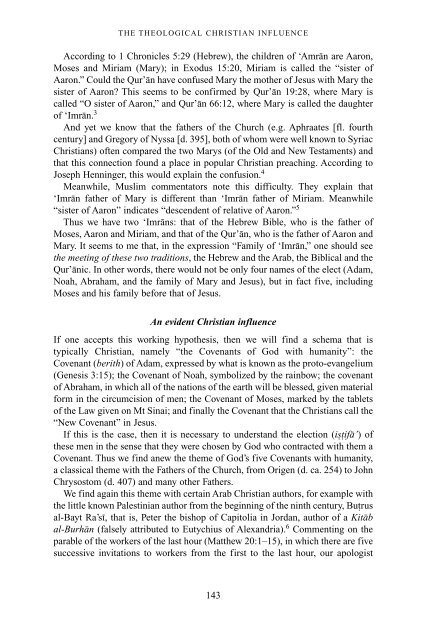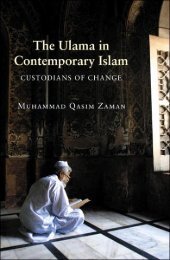The Qur'an in its historical context (pdf - Islam and Christian-Muslim ...
The Qur'an in its historical context (pdf - Islam and Christian-Muslim ...
The Qur'an in its historical context (pdf - Islam and Christian-Muslim ...
Create successful ePaper yourself
Turn your PDF publications into a flip-book with our unique Google optimized e-Paper software.
THE THEOLOGICAL CHRISTIAN INFLUENCE<br />
Accord<strong>in</strong>g to 1 Chronicles 5:29 (Hebrew), the children of ‘Amran are Aaron,<br />
Moses <strong>and</strong> Miriam (Mary); <strong>in</strong> Exodus 15:20, Miriam is called the “sister of<br />
Aaron.” Could the Qur’an have confused Mary the mother of Jesus with Mary the<br />
sister of Aaron? This seems to be confirmed by Qur’an 19:28, where Mary is<br />
called “O sister of Aaron,” <strong>and</strong> Qur’an 66:12, where Mary is called the daughter<br />
of ‘Imran. 3<br />
And yet we know that the fathers of the Church (e.g. Aphraates [fl. fourth<br />
century] <strong>and</strong> Gregory of Nyssa [d. 395], both of whom were well known to Syriac<br />
<strong>Christian</strong>s) often compared the two Marys (of the Old <strong>and</strong> New Testaments) <strong>and</strong><br />
that this connection found a place <strong>in</strong> popular <strong>Christian</strong> preach<strong>in</strong>g. Accord<strong>in</strong>g to<br />
Joseph Henn<strong>in</strong>ger, this would expla<strong>in</strong> the confusion. 4<br />
Meanwhile, <strong>Muslim</strong> commentators note this difficulty. <strong>The</strong>y expla<strong>in</strong> that<br />
‘Imran father of Mary is different than ‘Imran father of Miriam. Meanwhile<br />
“sister of Aaron” <strong>in</strong>dicates “descendent of relative of Aaron.” 5<br />
Thus we have two ‘Imrans: that of the Hebrew Bible, who is the father of<br />
Moses, Aaron <strong>and</strong> Miriam, <strong>and</strong> that of the Qur’an, who is the father of Aaron <strong>and</strong><br />
Mary. It seems to me that, <strong>in</strong> the expression “Family of ‘Imran,” one should see<br />
the meet<strong>in</strong>g of these two traditions, the Hebrew <strong>and</strong> the Arab, the Biblical <strong>and</strong> the<br />
Qur’anic. In other words, there would not be only four names of the elect (Adam,<br />
Noah, Abraham, <strong>and</strong> the family of Mary <strong>and</strong> Jesus), but <strong>in</strong> fact five, <strong>in</strong>clud<strong>in</strong>g<br />
Moses <strong>and</strong> his family before that of Jesus.<br />
An evident <strong>Christian</strong> <strong>in</strong>fluence<br />
If one accepts this work<strong>in</strong>g hypothesis, then we will f<strong>in</strong>d a schema that is<br />
typically <strong>Christian</strong>, namely “the Covenants of God with humanity”: the<br />
Covenant (berith) of Adam, expressed by what is known as the proto-evangelium<br />
(Genesis 3:15); the Covenant of Noah, symbolized by the ra<strong>in</strong>bow; the covenant<br />
of Abraham, <strong>in</strong> which all of the nations of the earth will be blessed, given material<br />
form <strong>in</strong> the circumcision of men; the Covenant of Moses, marked by the tablets<br />
of the Law given on Mt S<strong>in</strong>ai; <strong>and</strong> f<strong>in</strong>ally the Covenant that the <strong>Christian</strong>s call the<br />
“New Covenant” <strong>in</strong> Jesus.<br />
If this is the case, then it is necessary to underst<strong>and</strong> the election (istifa’) of<br />
these men <strong>in</strong> the sense that they were chosen by God who contracted with them a<br />
Covenant. Thus we f<strong>in</strong>d anew the theme of God’s five Covenants with humanity,<br />
a classical theme with the Fathers of the Church, from Origen (d. ca. 254) to John<br />
Chrysostom (d. 407) <strong>and</strong> many other Fathers.<br />
We f<strong>in</strong>d aga<strong>in</strong> this theme with certa<strong>in</strong> Arab <strong>Christian</strong> authors, for example with<br />
the little known Palest<strong>in</strong>ian author from the beg<strong>in</strong>n<strong>in</strong>g of the n<strong>in</strong>th century, Butrus<br />
al-Bayt Ra’si, that is, Peter the bishop of Capitolia <strong>in</strong> Jordan, author of a Kitab<br />
al-Burhan (falsely attributed to Eutychius of Alex<strong>and</strong>ria). 6 Comment<strong>in</strong>g on the<br />
parable of the workers of the last hour (Matthew 20:1–15), <strong>in</strong> which there are five<br />
successive <strong>in</strong>vitations to workers from the first to the last hour, our apologist<br />
143



